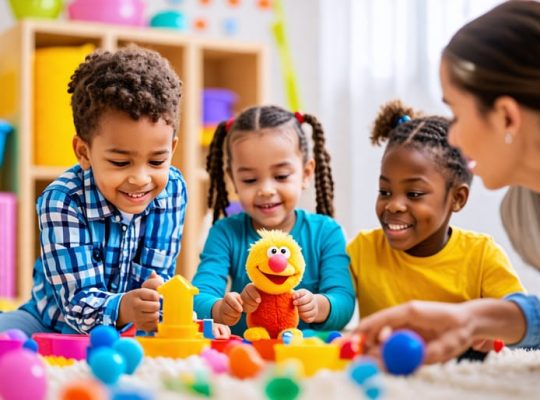Create routines that prioritize mental well-being by incorporating daily activities like mindfulness exercises and open conversations about feelings. This conveys the importance of mental health in a practical, consistent manner. Engage children in building the pillars of resilience to strengthen their emotional core, enabling them to manage challenges effectively. Recognize signs of mental distress early by being attentive to changes in mood or behavior, and encourage seeking help by destigmatizing therapy and support. Collaborate with teachers and healthcare professionals to create a supportive network that fosters an understanding environment, ensuring a comprehensive approach to mental well-being.
Understanding Children’s Mental and Emotional Well-Being
Key Components of Child Mental Health
Child mental health is shaped by several key components that are essential for their overall well-being, including emotional regulation, stress management, and resilience. Emotional regulation refers to a child’s ability to understand and manage their own feelings, which helps them respond to situations in a calm and thoughtful manner. It’s a skill that parents and educators can nurture by teaching children to express their feelings through words or creative outlets such as drawing or storytelling. Stress management involves equipping children with techniques to handle life’s challenges effectively. Simple strategies like deep breathing, engaging in physical activities, or taking time for relaxation can significantly impact their stress levels. Resilience, on the other hand, is the ability to bounce back from setbacks. Supportive relationships and environments play a crucial role in fostering resilience, as they provide children with secure foundations and confidence to face difficulties. By understanding and promoting these components, we can help build a strong mental foundation for children, ensuring they grow into healthy and balanced adults.

Common Mental Health Challenges in Children
Children may face several mental health challenges that can impact their daily lives, and understanding these can be crucial for parents, teachers, and healthcare professionals. Anxiety is one such common issue, often marked by excessive worry or fear that can interfere with a child’s ability to engage in regular activities. Symptoms might include restlessness, fatigue, and trouble concentrating. Meanwhile, depression in children might manifest as persistent sadness, loss of interest in favorite activities, or feelings of hopelessness. It’s essential to recognize these signs early to provide support and intervention.
Another prevalent challenge is Attention-Deficit/Hyperactivity Disorder (ADHD), characterized by symptoms such as inattention, hyperactivity, and impulsiveness. Children with ADHD might struggle with tasks that require sustained focus and often find it hard to sit still. Supporting children with ADHD involves understanding their unique needs and developing strategies to help them thrive in various environments. By acknowledging and addressing these challenges with compassion and empathy, caregivers and educators can play a pivotal role in fostering a nurturing and supportive environment for children’s mental well-being.
Influences on Children’s Mental and Emotional Well-Being
Family Dynamics and Home Environment
Family dynamics and the environment at home play a crucial role in shaping a child’s mental and emotional well-being. When children grow up in a supportive and stable home, they often feel safe and valued, leading to healthy emotional growth. Positive interactions with family members can foster a sense of belonging and self-worth, while consistent routines provide a comforting structure. On the other hand, a turbulent home environment, characterized by conflict or lack of support, may lead to stress and anxiety, potentially affecting a child’s long-term mental health.
Take Sarah’s story, for example—growing up in a loving home, she learned the value of open communication, which empowered her to express her emotions confidently. In contrast, children raised in unstable settings might struggle with trusting others or fear expressing themselves. According to child psychologist Dr. Laura Hill, promoting open dialogue and mutual respect at home is essential. Encouraging children to cultivate a healthy relationship with food plays into this, as it underscores the importance of nurturing their overall well-being, both mentally and physically. Creating a home environment filled with empathy and understanding can provide children with the foundation they need to thrive, making a significant difference in their mental health journey.

School and Social Interactions
The school environment plays a pivotal role in the mental and emotional well-being of children, providing not only education but also key social interactions. Schools serve as a backdrop where children learn to navigate relationships, fostering skills like empathy, communication, and conflict resolution. These experiences heavily influence their self-esteem and sense of belonging, both integral to their overall well-being. Positive interactions with peers and supportive relationships with teachers can create a nurturing atmosphere that bolsters confidence and emotional resilience.
Personal stories often highlight how a caring teacher or a solid friendship has been a source of comfort and encouragement during challenging times. Conversely, a lack of support or exposure to bullying can negatively impact a child’s self-worth and lead to increased anxiety or depression. Therefore, fostering a positive school climate is crucial. Encouraging open communication and promoting inclusivity can help children thrive mentally and emotionally, creating a safe haven where they feel valued and supported. Engaging regularly with your child’s experiences at school and being attuned to changes in their behavior or mood can provide insights and guidance on when to seek additional support. Experts stress the importance of a collaborative approach involving parents, teachers, and healthcare professionals to ensure every child has the support needed to flourish.
Societal and Technological Factors
In today’s fast-paced world, media, culture, and technology significantly influence children’s mental health. The impact of social media and the effects of screen time are well-documented, highlighting the importance of balanced technology use. Media often shapes cultural norms, affecting a child’s self-esteem and emotional well-being. Experts suggest that a diverse cultural perspective nurtures resilience in children, offering them various ways to interpret and handle life’s challenges. Parents and educators should foster open discussions about media content, encouraging critical thinking and emotional intelligence. This approach not only supports children’s mental health but also prepares them for a healthier interaction with technology and society.
Strategies to Foster Emotional and Mental Well-Being
Creating a Supportive Environment
Creating a supportive environment for mental and emotional well-being starts with open communication and genuine empathy. At home, prioritize creating a space where children feel safe to express their thoughts and emotions. Encourage open dialogues by actively listening to their concerns without judgment. Share personal stories when appropriate to help them feel understood, showing that everyone encounters challenges. Incorporate small rituals like family meals or weekly check-ins to build trust and connection.
In schools, teachers and staff can foster inclusivity by offering activities that celebrate diversity and encourage teamwork. Teachers can play a crucial role by recognizing individual strengths and acknowledging progress, thereby boosting self-esteem. Create a classroom atmosphere that accommodates different learning styles and emotional needs, providing quiet spaces for those who may need a break. Collaboration with mental health professionals ensures that both educators and students have access to resources tailored to their needs.
Healthcare professionals can offer guidance by educating families and schools on recognizing signs of stress or anxiety and when to seek help. By integrating expert opinions and emphasizing the importance of community, everyone involved can contribute significantly to nurturing a supportive environment where children thrive emotionally and mentally.
Promoting Healthy Communication
Enhancing communication is crucial for fostering mental and emotional well-being in children. Start by creating a safe and welcoming environment where children feel heard and valued. Listening actively and empathetically is key—pay attention, make eye contact, and respond with understanding. Encourage open dialogue by asking open-ended questions, allowing children to express their feelings without fear of judgment. It’s essential to model healthy communication by sharing your thoughts and emotions appropriately, setting an example for them to follow.
A personal story that resonates can illustrate the power of trustful communication. For instance, Sarah, a mother of two, noticed her son was withdrawing. She decided to spend uninterrupted time engaging with him, listening without interrupting. This approach gradually reassured him, leading to more open conversations about his experiences at school. Healthcare professionals and teachers can also benefit from this method by building rapport and trust, facilitating a connection, and encouraging children to express themselves freely. These techniques help create a nurturing environment, paving the way for positive mental health outcomes.
Incorporating Mindfulness and Relaxation Practices
Helping children develop mindfulness and relaxation skills can significantly benefit their emotional well-being. Simple practices, such as deep breathing, can be easily introduced at home or in the classroom. Encourage children to sit comfortably, close their eyes, and take slow, deep breaths, imagining they are filling a balloon with air. This helps them focus and feel calmer. Another practice is a mindful walk, where kids pay attention to the sounds, smells, and sights around them, fostering awareness of their surroundings.
Incorporating bedtime relaxation routines can also be beneficial. A short story that combines relaxation techniques, like tensing and relaxing different body parts, can help children unwind and prepare for sleep. Additionally, creating a designated quiet space, perhaps with soft pillows and calm lighting, provides a safe area for children to retreat and self-soothe when they feel overwhelmed.
These practices not only help children manage stress but also teach important life skills for emotional resilience and self-regulation.

When to Seek Professional Help
Identifying Warning Signs
Recognizing when a child might need professional help is crucial for their mental and emotional well-being. Some warning signs include noticeable changes in behavior, such as withdrawal from friends and family, loss of interest in previously enjoyed activities, or significant changes in eating or sleeping patterns. Be alert to frequent mood swings, excessive worry or anxiety, and sudden outbursts of anger or sadness. If a child expresses feelings of hopelessness or talks about self-harm, it’s vital to take these signs seriously and seek immediate professional guidance. Physical symptoms like unexplained headaches or stomachaches can also indicate emotional distress. Trust your instincts; if something feels off, seeking advice from a mental health professional can provide the support needed to help the child thrive.
Navigating the Healthcare System
Finding the right mental health professional for your child can significantly impact their well-being. It’s important to start by considering your child’s specific needs and challenges. Consulting your child’s pediatrician can be a helpful first step; they often have recommendations for mental health professionals specializing in children’s care. Engaging with teachers and school counselors can also offer insights into supportive resources available within the education system. Personal stories from other parents can often shed light on the practical aspects of finding the right fit. When choosing a professional, ensure they are compassionate and experienced in working with children. Always feel empowered to ask questions about their approach and check if their philosophy aligns with your goals. Remember, finding the right support is a journey, and it’s okay to seek different options until it feels right for your child and family.
Conclusion
In conclusion, our journey through understanding children’s mental well-being reveals a vital truth: every child’s encounter with undefined challenges offers an opportunity for growth and support. By emphasizing active listening and recognizing early signs of distress, parents, teachers, and healthcare professionals can form the first line of defense in nurturing a child’s mental health. Personal stories and expert opinions alike illuminate the profound impact of compassion and patience. Each child’s experience is unique, underscoring the importance of personalized approaches to care. Encouraging children to express feelings and providing them with the vocabulary to do so can transform fear and uncertainty into pathways of healing and resilience.
Creating an environment where children feel safe, understood, and validated fosters both their mental and emotional development. Through these efforts, we lay a foundation for lifelong wellness. Remember that reaching out for professional help when needed is an empowering step, not a failure. As engaged and informed supporters, we play a crucial role in shaping a more understanding and supportive world for our children. Let us remain steadfast in promoting open dialogues, advocating for accessible resources, and, above all, cherishing the mental well-being of every child with empathy and unwavering support. Together, we can navigate any undefined challenges that arise, hand in hand with courage and hope.







